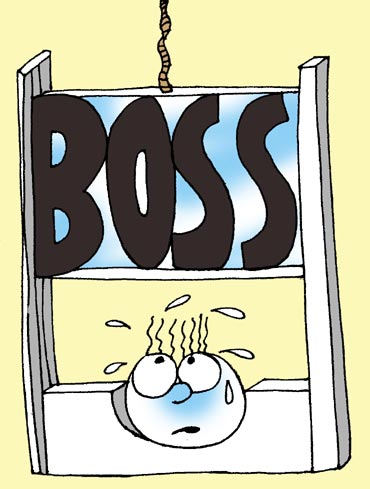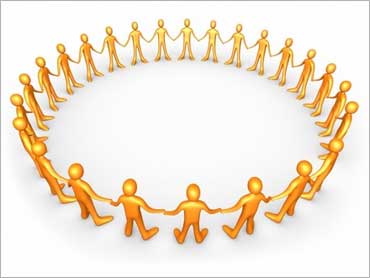 | « Back to article | Print this article |
Time to consign the Org Chart to the waste basket?
Authority and prestige in network industries no longer rest on your ability to control people 'below you'; they depend on your capacity to add value to the network, says Ajit Balakrishnan.
Every era leaves behind symbol systems well after it has passed; the pyramid-like Organisation Chart or Org Chart is possibly one such symbol system and it is a relic from the Industrial Revolution.
The Industrial Revolution itself has meant many things to many people. In the minds of some, it evokes sprawling textile factories spewing smoke, and workers pulling and pushing levers under the glaring eyes of their supervisors.
For others, the Industrial Revolution means progress, the move from low-productive farms to efficient factories.
Gandhiji took a dim view of the Industrial Revolution. That view is neatly coded in the Congress party's flag of that time.
Click NEXT to read on . . .
Time to consign the Org Chart to the waste basket?
The hand-spinning wheel or charkha, which was destroyed by the Industrial Revolution, found a place of honour at the centre on a white background with green and saffron bands above and below it.
The pyramidal Org Chart, a symbolic representation of how work is organised, is one such symbol system.
A typical Org Chart starts with a box at the top depicting the Overall Leader, with arrows pointing downwards from him to a row of boxes representing Smaller Leaders of 'functions' such as sales, finance and marketing.
It then shows more rows below each with its set of boxes which, in turn, have arrows pointing down to more rows of more boxes depicting Even Smaller Leaders.
Click NEXT to read on . . .
Time to consign the Org Chart to the waste basket?
Such Org Charts are used for a wide variety of purposes. They are used, for example, to explain to outsiders and new employees 'how this organisation works'.
People at higher levels in such a chart see it as an inalienable right that they are paid more than those at lower levels in the chart. Offices and even office furniture must reflect the position in the chart; people at higher levels expect to have larger offices with greater privacy and more elaborate furnishings. Organisations that have such neat Org Charts are applauded as 'well-managed'.
However, organisational theorists today are starting to cast a sceptical eye on such neat Org Charts. Do these charts mean that a person at one level in the chart should conduct a task-related conversation only with a person in the box above or below him and directly linked to him by an arrow?
Does it mean that a person may issue work directions only to those in a row below him and directly connected to him by an arrow in the Org Chart?
Click NEXT to read on . . .
Time to consign the Org Chart to the waste basket?
The hidden code behind these charts, the sceptical organisation theorists say, is that work life ought to be organised in today's Information Age exactly as it was designed in the Industrial Revolution era of the eighteenth, nineteenth and early twentieth centuries.
In that era, the key to productivity and, therefore, to organisational success, was the principle of economies of scale and this was supposed to be obtained by making standardised widgets in very large quantities.
Henry Ford encapsulated this thinking best in his dictum that you could have any colour of his Ford Model T car as long as it was black.
Unfortunately, true Information Age organisations derive their success not from economies of scale and standardised widgets; they bank on 'network effects', the phenomena by which, for example, a single mobile phone has no value, and two mobile phones mean that at least you can talk to another person, thus each mobile phone acquires some value.
Click NEXT to read on . . .
Time to consign the Org Chart to the waste basket?
Extending this further, 100 mobile phones mean that each person can now talk to at least 99 other people and so on.
In other words, as an increasing number of people use mobile phones, each mobile phone becomes more valuable, so does the value of the network that connects them.
In a visual depiction, a mobile phone network that shows each mobile phone user connected to every other mobile phone user may indicate that it is a more valuable entity than one in which such connections are sparse.
Such network effects are starting to be uncovered not just in the Internet and Web industries but also in academic institutions, news organisations, Hollywood, research labs, stock markets and many, many other places.
Click NEXT to read on . . .
Time to consign the Org Chart to the waste basket?
In each of these cases, the higher the extent of network connections of people within and across organisations, the more is the opportunity for value creation.
Authority and prestige in such network industries no longer rest on your ability to command and control people 'below you'; they depend on your capacity to add value to the network as a whole.
The pyramid, therefore, flattens into a picture of extensive networks with critical people at the nodes.
So, is it time we neatly and silently folded and consigned the pyramidal Org Chart to the waste-paper basket?
Please send your comments to ajitb@rediffmail.com






